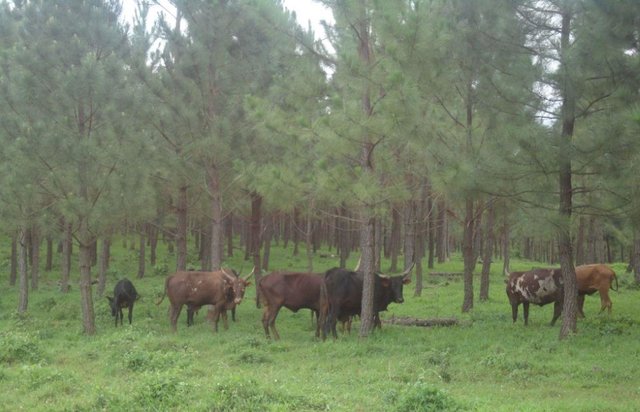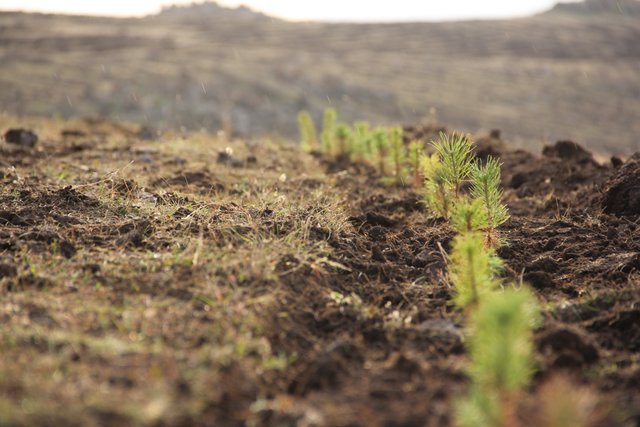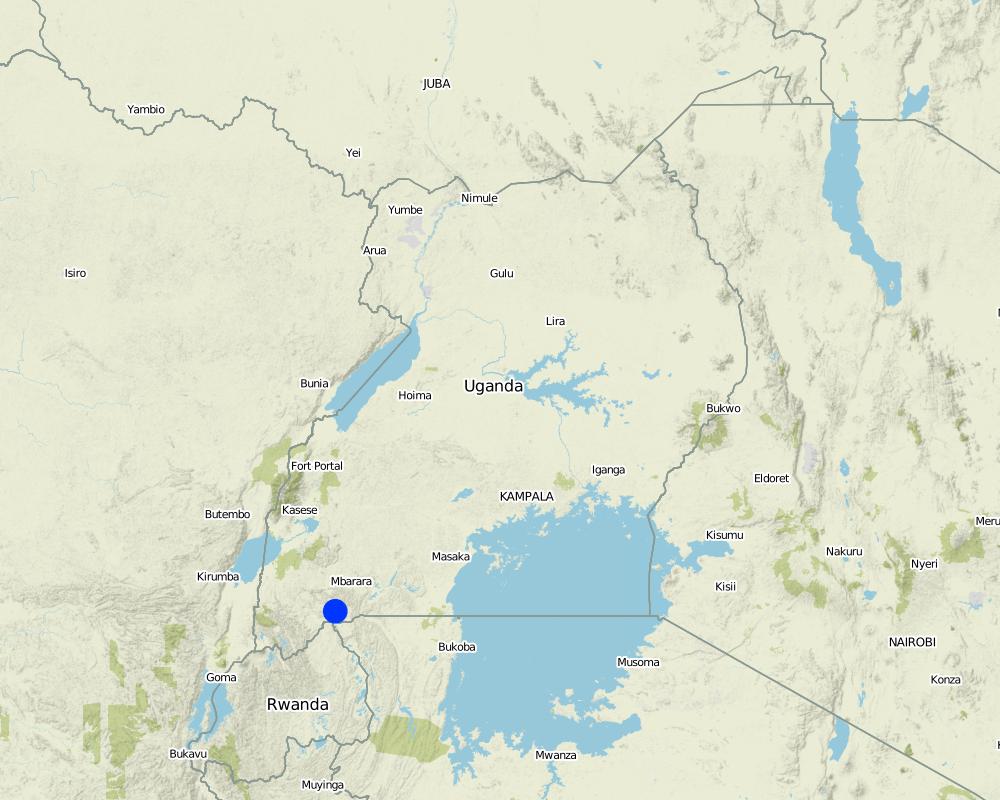Afforestation/Tree planting [乌干达]
- 创建:
- 更新:
- 编制者: Wilson Bamwerinde
- 编辑者: –
- 审查者: Fabian Ottiger
Okuhinga emiti.
approaches_2587 - 乌干达
查看章节
全部展开 全部收起1. 一般信息
1.2 参与方法评估和文件编制的资源人员和机构的联系方式
SLM专业人员:
Mazimakwo Kukundakwe
Kabale District
乌干达
SLM专业人员:
Mushabe Joshua
Ntungamo District
乌干达
SLM专业人员:
Tugaine Richard
Ntungamo District
乌干达
SLM专业人员:
Matsiko Polly
0782900819
Nshenyi, Kitwe Town Council
乌干达
有助于对方法进行记录/评估的项目名称(如相关)
The Transboundary Agro-ecosystem Management Project for the Kagera River Basin (GEF-FAO / Kagera TAMP )有助于对方法进行记录/评估的机构名称(如相关)
Ntungamo District - 乌干达有助于对方法进行记录/评估的机构名称(如相关)
Kabale District Local Government (Kabale District Local Government) - 乌干达有助于对方法进行记录/评估的机构名称(如相关)
Kitwe Town Council - 乌干达1.3 关于使用通过WOCAT记录的数据的条件
(现场)数据是什么时候汇编的?:
19/04/2013
编制者和关键资源人员接受有关使用通过WOCAT记录数据的条件。:
是
1.4 SLM技术问卷的参考

Afforestation /Tree planting [乌干达]
Pine tree forests have been strategically planted on previously bare ridges and slopes to mitigate mass soil movement.
- 编制者: Wilson Bamwerinde

High-altitude afforestation for erosion control [亚美尼亚]
Afforestation is a key technologies to protect soil against erosion and provide a wide range of ecosystem services. In this case, afforestation at high altitudes, which is particularly challenging, with the primary purpose of erosion control were planted in small patches with different methods. They form the basis for future …
- 编制者: Hanns Kirchmeir
2. SLM方法的描述
2.1 该方法的简要说明
Tree planting carried out by individual land users on hilly slopes to improve soil cover ,reduce wind strength , provide wood fuel & household income.
2.2 该方法的详细说明
该方法的详细说明:
Aims / objectives: -To conserve the degraded hill by planting trees and reduce soil erosion.
-To reduce wind strength.
-To increase sources of fuel wood.
-To diversify sources of future household income.
Methods: -Mobilization of farmer field members to participate in tree planting , to increase tree cover in the area.
-Facilitation of planning meetings for farmer field school members in identifying tree planting needs.
-Purchase and raising of tree seedlings and tree nursery beds for tree seedlings.
-Distribution of tree seedlings to willing farmer school members for planting.
-Provision of training in tree planting technologies prior to distribution.
-Tree planting and management.
Stages of implementation: -Planning of tree planting needs.
-Purchase of tree seedlings and raising of indigenous tree seedlings.
-identification of planting sites.
-capacity building in tree planting technologies.
-making of holes for planting tree seedlings.
-Making of holes for tree planting seedlings.
-Planting of tree seedlings.
Role of stakeholders: -Mobilization of farmer field school members by service providers.
-Training the beneficiary members in tree planting by service providers/facilitators.
-Provision of funds for purchase of tree seedlings by FAO under the Kagera TAMP project.
Other important information: The land users and the farmer field school members had seen tree planting activities in neighbouring areas but they had thought that such activities could only be done by government.
But through mobilization farmers have realized the importance and possibility of farmers benefiting from tree planting.
2.5 采用该方法的国家/地区/地点
国家:
乌干达
区域/州/省:
Uganda
有关地点的进一步说明:
Ntungamo
Map
×2.6 该方法的开始和终止日期
注明开始年份:
2011
终止年份(若不再采用该方法):
2015
2.7 方法的类型
- 基于项目/方案
2.8 该方法的主要目的/目标
The Approach focused mainly on SLM with other activities (Reduction of wind strength ,provision of wood fuel and contribute to household income. )
-To conserve degraded hill slopes against erosion due to overstocking.
-To reduce wind strength in the area by increasing tree cover in the area.
-To increase source of wood fuel in the area.
-To diversify the future source of household incomes in the area among the communities.
The SLM Approach addressed the following problems: -To reduce soil erosion on degraded hill slopes.
-To reduce the strength of which wind affect the area in rainy seasons.
-To increase access to wood fuel sources.
-To diversify future household income.
-To get cheap timber for staking bananas.
2.9 推动或妨碍实施本办法所适用的技术的条件
社会/文化/宗教规范和价值观
- 阻碍
Lack of initiative to undertake tree planting.
Treatment through the SLM Approach: mobilization and sensitization into farmer field school approach.
财务资源和服务的可用性/可得性
- 阻碍
Inadequate funds for tree seedling purchase.
Treatment through the SLM Approach: Seek assistance from FAO.
法律框架(土地使用权、土地和水使用权)
- 启动
The existing land ownership, land use rights / water rights greatly helped the approach implementation: Land user owns the land and thus did not face any resistance.
了解SLM,获得技术支持
- 阻碍
Inadequate capacity on tree planting technologies and values in tree planting.
Treatment through the SLM Approach: Mobilization and training /sensitization in tree planting benefits.
3. 相关利益相关者的参与和角色
3.1 该方法涉及的利益相关者及其职责
- 当地土地使用者/当地社区
Farmer field school members , Facilitators
- SLM专家/农业顾问
Farmer field trainers
- 国际组织
- Facilitators
3.2 当地土地使用者/当地社区参与该方法的不同阶段
| 当地土地使用者/当地社区的参与 | 指定参与人员并描述活动 | |
|---|---|---|
| 启动/动机 | 外部支持 | The land users were mobilized by national project coordinator. |
| 计划 | 外部支持 | The land users were mobilized and facilitated to identify their problems related to environmental degradation & priorities were made. |
| 实施 | 自我动员 | Land users were responsible for tree planting. |
| 监测/评估 | 外部支持 | Project officials are to undertake M&E. |
| Research | 无 |
3.4 有关SLM技术选择的决策
具体说明谁有权决定选择要实施的技术:
- 主要是土地使用者,由SLM专家提供支持
解释:
After mobilization and sensitization of the land users in farmer field schools ,the land users decided to under take tree planting.
Decisions on the method of implementing the SLM Technology were made by mainly by land users supported by SLM specialists. Land users made decision on the technology alone.
4. 技术支持、能力建设和知识管理
4.1 能力建设/培训
是否为土地使用者/其他利益相关者提供培训?:
是
明确受训人员:
- 土地使用者
培训形式:
- 农民对农民
- 示范区域
4.2 咨询服务
土地使用者有权使用咨询服务吗?:
是
指明是否提供了咨询服务:
- 在固定中心
说明/注释:
Name of method used for advisory service: Training and awareness.; Key elements: mobilization, identification of problems related to land degradation. , Ranking of severity of land degradation types. SLM approaches were then selected by land users after analysis & synthesis of the problems.
Advisory service is inadequate to ensure the continuation of land conservation activities; Land use needs continuous follow-up and little support provided in terms of financial & advisory.
4.3 机构强化(组织发展)
是否通过这种方法建立或加强了机构?:
- 否
4.4 监测和评估
监测和评估是该方法的一部分吗?:
是
注释:
technical aspects were regular monitored by land users through observations; indicators: Progress of tree growth.
There were few changes in the Approach as a result of monitoring and evaluation
There were no changes in the Technology as a result of monitoring and evaluation
4.5 研究
研究是该方法的一部分吗?
是
- Baseline survey on the needs assessment.
提供进一步的细节,并指出是谁做的研究:
Trainers of farmer field schools mobilized farmer field school land users ,who identified their problems and how they can be solved.
Research was carried out on-farm
5. 融资和外部物质支持
5.1 该方法中SLM组成部分的年度预算
如果不知道准确的年度预算,请给出一个范围:
- < 2,000
注释(例如主要的资助来源/主要捐助者):
Approach costs were met by the following donors: international (FAO): 70.0%; local community / land user(s) (mobilization,facilitation of meals during trainings.etc): 30.0%
5.2 为土地使用者提供财政/物质支援
土地使用者是否获得实施该技术的财政/物质支持?:
是
5.3 对特定投入的补贴(包括劳动力)
- 设备
| 具体说明哪些投入得到了补贴 | 程度如何 | 对补贴做出具体说明 |
|---|---|---|
| 工具 | 部分融资 | |
- 农业
| 具体说明哪些投入得到了补贴 | 程度如何 | 对补贴做出具体说明 |
|---|---|---|
| 化肥 | 部分融资 | |
如果土地使用者的劳动力是一项重要的投入,那么是不是:
- 以粮换工
注释:
Food for work, paid in cash and rewarded with other material support
Shs 5000 each person per day.
most funds provided by FAO and small proportion by land users.
5.4 信用
是否根据SLM活动的方法给予信用值?:
否
6. 影响分析和结论性陈述
6.1 方法的影响
该方法是否帮助土地使用者实施和维护SLM技术?:
- 否
- 是,很少
- 是,中等
- 是,支持力度很大
-Retardation of soil erosion. -Provision of soil cover.
该方法是否有助于社会和经济弱势群体?:
- 否
- 是,很少
- 是,中等
- 是,支持力度很大
No disadvantaged group involved.
Did other land users / projects adopt the Approach?
- 否
- 是,很少
- 是,中等
- 是,支持力度很大
2 to 7 land users adopted the approach towards tree planting.
Did the Approach lead to improved livelihoods / human well-being?
- 否
- 是,很少
- 是,中等
- 是,支持力度很大
Did the Approach help to alleviate poverty?
- 否
- 是,很少
- 是,中等
- 是,支持力度很大
The trees have not yet matured for harvesting.
6.2 土地使用者实施SLM的主要动机
- 增加生产
- 增加利润(能力),提高成本效益比
generate income.
- 规章制度(罚款)/执行
generate income.
- 环境意识
conserve the environment
- well-being and livelihoods improvement
6.3 方法活动的可持续性
土地使用者能否维持通过该方法实施的措施(无外部支持的情况下)?:
- 是
6.4 该方法的长处/优点
| 土地使用者眼中的长处/优势/机会 |
|---|
| 1. Green environment (How to sustain/ enhance this strength: Plant more trees. ) |
| 2. Reduce global warming (How to sustain/ enhance this strength: Plant more trees for carbon absorption.) |
| 3. Cool environment (How to sustain/ enhance this strength: Plant more trees on the bare hills.) |
| 4. Increase productivity. (How to sustain/ enhance this strength: Better monitoring and evaluation. ) |
| 编制者或其他关键资源人员认为的长处/优势/机会 |
|---|
| 1. Control of soil erosion. (How to sustain/ enhance this strength: Plant more trees. ) |
| 2.Improved soil cover. (How to sustain/ enhance this strength: Plant more trees. ) |
| 3. Reduction of wind speed. (How to sustain/ enhance this strength: Plant more trees in wind prone areas.) |
| 4. Increase wood fuel in future. |
6.5 该方法的弱点/缺点以及克服它们的方法
| 土地使用者认为的弱点/缺点/风险 | 如何克服它们? |
|---|---|
| 1. It is costly. | Subsidize land users. |
| 2. Long term returns. | Plant some quick maturing trees. |
| 编制者或其他关键资源人员认为的弱点/缺点/风险 | 如何克服它们? |
|---|---|
| 1. It is costly to plant trees. | Provide subsides to land users who are practicing the technology. |
7. 参考和链接
7.1 方法/信息来源
- 实地考察、实地调查
- 与土地使用者的访谈
7.2 参考可用出版物
标题、作者、年份、ISBN:
1. Managemenrt plan for sawlog production ,Project proposal by Tibesigwa Mukasa,2006.
链接和模块
全部展开 全部收起链接

Afforestation /Tree planting [乌干达]
Pine tree forests have been strategically planted on previously bare ridges and slopes to mitigate mass soil movement.
- 编制者: Wilson Bamwerinde

High-altitude afforestation for erosion control [亚美尼亚]
Afforestation is a key technologies to protect soil against erosion and provide a wide range of ecosystem services. In this case, afforestation at high altitudes, which is particularly challenging, with the primary purpose of erosion control were planted in small patches with different methods. They form the basis for future …
- 编制者: Hanns Kirchmeir
模块
无模块


